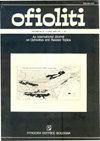CORUNDUM-BEARING VEINS IN CHLORITITE FROM THE ETIROL-LEVAZ AUSTROALPINE CONTINENTAL SLICE (VALTOURNENCHE, AOSTA, ITALY)
IF 1.3
4区 地球科学
Q2 GEOLOGY
引用次数: 0
Abstract
The high-pressure (HP) continental Etirol-Levaz slice (ELS) is exposed on the right side of the Valtournenche (Aosta) at the contact between the overlying blueschist-facies Combin Zone and the underlying eclogite-facies Zermatt-Saas Zone. The ELS contains a layered metagabbro showing a complex evolution, which includes the pre-Alpine high-temperature (HT) recrystallization of the igneous mineralogies, and the polyphase Alpine metamorphism, initially at high-pressure (HP) quartz eclogite-facies, and greenschist-facies (GS) retrogression.In this paper, an unusual corundum-bearing ultramafic rocks associated with metagabbros are described. The studied sample is a Mg-chloritite with relict green spinel partly replaced by corundum, Mg-beltrandoite-2N3S (a new mineral of the hogbomite supergroup), Mg-chlorite and dolomite. The rock is crossed by mm- to cm-thick veins composed of coarse-grained corundum + Mg-chlorite + dolomite. P-T phase-diagram projections indicate that the corundum-bearing assemblages formed in the presence of a water-rich fluid (X(CO2) ≤ 0.04), during retrograde decompressional evolution. This stage follows the prograde HP-peak of the associated eclogites. The newly inferred prograde-to-retrograde P-T path suggests that the ELS and the underlying Zermatt-Saas Zone shared a common Alpine metamorphic evolution.The detailed study of the relict minerals preserved in the chloritite indicates its pre-Alpine protolith, a green spinel websterite, and its evolution, characterized by a high-T recrystallization of the original igneous asemblages. During the Alpine orogeny, the spinel websterite experienced metasomatic hydration that converted the original igneous rock into a chloritite.奥地利阿尔卑斯山脉大陆片(意大利奥斯塔瓦尔图嫩切)绿泥石中的含钴矿脉
高压(HP)大陆Etirol Levaz切片(ELS)暴露在Valtourneche(Aosta)的右侧,位于上覆蓝片岩相Combin带和下伏榴辉岩相Zermatt Saas带之间的接触处。ELS包含一个层状变辉长岩,显示出复杂的演化,包括火成矿物的前阿尔卑斯高温(HT)重结晶,以及多相阿尔卑斯变质作用,最初处于高压(HP)石英榴辉岩相和绿片岩相(GS)退变质。本文描述了一种与变质辉长岩伴生的不寻常的含刚玉超镁铁质岩石。所研究的样品是一种镁绿泥石,其残余的绿色尖晶石部分被刚玉、镁-钙矾石-2N3S(一种新的辉长岩超群矿物)、镁绿泥石和白云石取代。岩石上有毫米至厘米厚的矿脉,由粗粒刚玉+镁绿泥石+白云石组成。P-T相图投影表明,在逆解压演化过程中,在富水流体(X(CO2)≤0.04)的存在下形成了含刚玉的组合。该阶段遵循伴生榴辉岩的进变质高压峰值。最新推断的由进到退的P-T路径表明,ELS和下伏的采尔马特-萨斯带具有共同的阿尔卑斯变质演化。对绿泥石中保存的残余矿物的详细研究表明,绿泥石的前阿尔卑斯原岩是一种绿色尖晶石二石,其演化特征是原始火成岩组合的高T重结晶。在阿尔卑斯造山运动期间,尖晶石二橄榄石经历了交代水合作用,将原始火成岩转化为绿泥石。
本文章由计算机程序翻译,如有差异,请以英文原文为准。
求助全文
约1分钟内获得全文
求助全文
来源期刊

Ofioliti
地学-地质学
CiteScore
2.40
自引率
7.70%
发文量
1
期刊介绍:
Since 1976, Ofioliti provides an international forum for original contributions and reviews in the field of the geodynamics, petrology, geochemistry, biostratigraphy, stratigraphy, tectonics and paleogeography applied to ophiolitic terrains and modern oceanic lithosphere, including their sedimentary cover. Studies of topics such as geodynamics of the mantle, the evolution of orogens including ophiolites and paleoceanography are also welcome
 求助内容:
求助内容: 应助结果提醒方式:
应助结果提醒方式:


